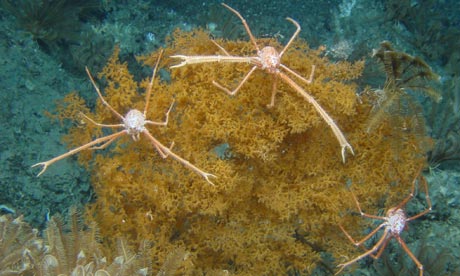All of the tropical coral reefs in the world will be disintegrating by the end of the century because of the rising acidity of the oceans caused by a build-up of man-made carbondioxide in the atmosphere, a study has found.
Coral reefs start to disintegrate when the acidity of the oceans rises beyond a certain threshold, and this point is likely to be reached before 2100, said Jacob Silverman of the Carnegie Institution of Science in Washington.
Carbon dioxide in the air dissolves in the sea to form carbonic acid, which interferes with the ability of coral organisms to make their calcium carbonate shells which form coral reefs, Dr Silversman said. But once the shells stop forming, the reef quickly crumbles.
A mathematical model was used to study how 9,000 coral reefs from around the world would respond to rising levels of carbon dioxide and increasing ocean acidity, Dr Silverman told the American Association for the Advancement of Science in San Diego.
"A global map produced on the basis of these calculations shows that all coral reefs are expected to stop their growth and start to disintegrate when atmosphere CO2 reaches 560 parts per million – double its pre-industrial level – which is expected by the end of the 21st-century," he told the meeting.
"Thus these ecosystems, which harbour the highest diversity of marine life in the oceans, may be severely reduced within less than 100 years."
The findings were based on a detailed study of how increasing acidity affects the metabolism and growth of a large area of fringing coral reef in the northern Red Sea. The scientists found that the ability of corals to form their calcium skeletons was strongly dependent on acidity and, to a lesser extent, temperature.
Coral reefs are sometimes considered to be the "rainforests of the oceans" because they are home to a wide variety of fish and other wildlife, supporting about a quarter of all marine organisms. They also provide food for about 500 million people around the world. Atmospheric levels of carbon dioxide are higher now than at any time in the last 650,000 years, and are continuing to rise as a result of the burning of fossil fuels. Between a third and a half of the CO2 produced since the start of the industrial revolution has dissolved in the oceans.
Scientists have estimated that some 118 billion tonnes of carbon released into the air as carbon dioxide between 1800 and 1994 has been taken up by the oceans.
Dr Simon Donner, of the University of British Columbia in Canada, said increasing ocean temperatures also make coral reefs more susceptible to "bleaching", caused by the loss of the photosynthetic algae on which the coral organisms depend.
Corals have a symbiotic relationship with the microscopic algae that live in their tissues. As well as giving coral its vibrant colour, the algae provide the reef creatures with most of theirenergy.





















